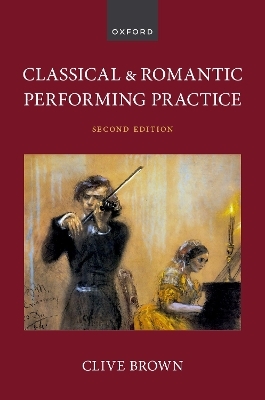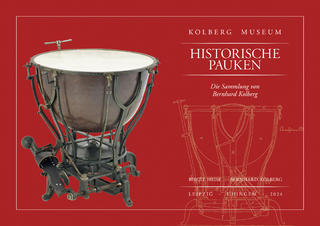
Classical and Romantic Performing Practice
Oxford University Press Inc (Verlag)
978-0-19-758162-9 (ISBN)
- Lieferbar (Termin unbekannt)
- Versandkostenfrei innerhalb Deutschlands
- Auch auf Rechnung
- Verfügbarkeit in der Filiale vor Ort prüfen
- Artikel merken
Drawing upon early recordings, documentary evidence, and the few surviving mechanical instruments, author Clive Brown investigates how we might rediscover the subliminal messages Classical and Romantic music notation was intended to convey to performers and argues that composers' intentions for their notation ought not to be confused with their expectations for its execution. The use of expressive practices that often involve substantial deviations from a conventional modern reading of the notation is not only a legitimate but also an essential element in getting closer to the composer's conception. The following topics are investigated over the course of sixteen chapters: metrical and rhetorical accentuation, dynamics, articulation, string-instrument bowing, phrasing, expression, tempo, tempo flexibility, ornamentation and improvisation, asynchrony, arpeggiation, rhythmic flexibility, sliding effects (portamento), and trembling effects (tremolo, vibrato). The book offers ample evidence to demonstrate that, in many respects, the sound worlds in which Mozart, Beethoven, Wagner, and Brahms created their music were more radically different from ours than is generally assumed.
After it was published in 1999, the first edition of Classical and Romantic Performing Practice 1750-1900 quickly ensconced itself as a must-read for all students, scholars, and performers in historically informed performance. The revised and expanded second edition incorporates new information resulting from the author's continued research and practical experimentation since the publication of the original edition, and has benefitted greatly from his work with a succession of talented doctoral students over the years.
Clive Brown was a member of the Faculty of Music at Oxford University from 1980 to 1991. He is now Emeritus Professor of Applied Musicology at the University of Leeds and continues to teach part-time at the Universität für Musik und darstellende Kunst, Vienna. A concert violinist, his work concentrates on practice-led research and performance. During the 1990s and early 2000s, he was concertmaster of the Cambridge Classical Orchestra. As leader of the Ferdinand David Ensemble, he took part in many chamber performances with his practice-led doctoral students.
Introduction
1. Accentuation in Theory
2. Accentuation in Practice
3. The Notation of Accents and Dynamics
4. Articulation and Phrasing
5. Articulation and Expression
6. The Notation of Articulation and Phrasing
7. String Bowing
8. Tempo
9. Alla Breve
10. Terms of Tempo and Expression
11. Tempo Modification
12. Appoggiaturas, Trills, Turns, and Related Ornaments
13. Improvised ornamentation and Embellishment
14. Asynchrony, Arpeggiation, and Flexible Rhythm
15. Portamento and other sliding effects
16. Vibrato and other Trembling Effects
Index
| Erscheinungsdatum | 05.02.2025 |
|---|---|
| Zusatzinfo | Over 500 music examples |
| Verlagsort | New York |
| Sprache | englisch |
| Maße | 157 x 235 mm |
| Gewicht | 1533 g |
| Themenwelt | Kunst / Musik / Theater ► Musik ► Instrumentenkunde |
| Kunst / Musik / Theater ► Musik ► Klassik / Oper / Musical | |
| Kunst / Musik / Theater ► Theater / Ballett | |
| ISBN-10 | 0-19-758162-5 / 0197581625 |
| ISBN-13 | 978-0-19-758162-9 / 9780197581629 |
| Zustand | Neuware |
| Informationen gemäß Produktsicherheitsverordnung (GPSR) | |
| Haben Sie eine Frage zum Produkt? |
aus dem Bereich


